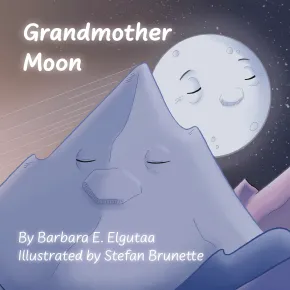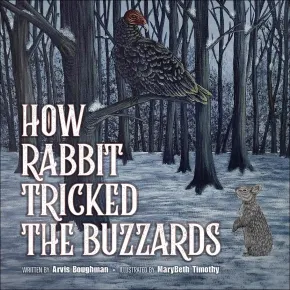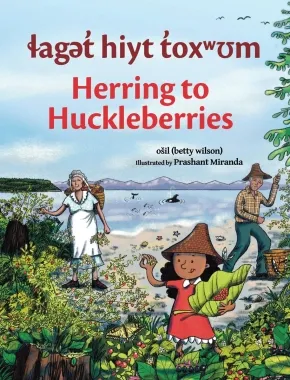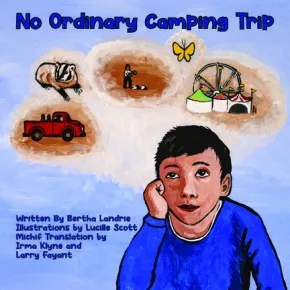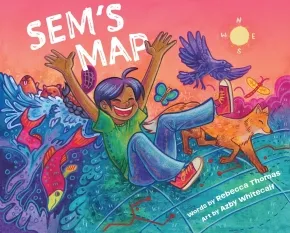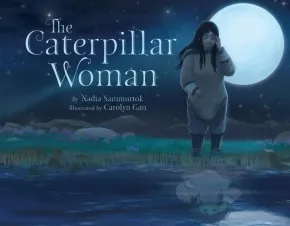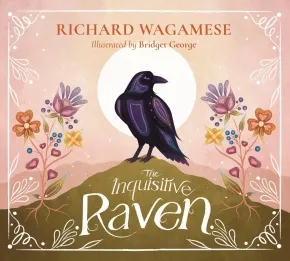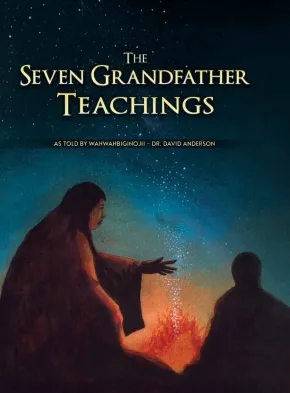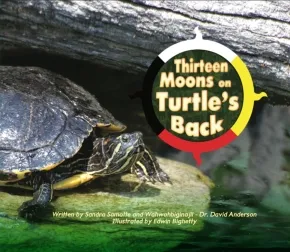
Indigenous Stories
1
-
15
of
247 Results;
Sort By
Go To
of 17
A Collection of Lost Tails: & Other Animal Stories
$11.95
Format:
Paperback
Text Content Territories:
Indigenous;
ISBN / Barcode: 9781738736799
Synopsis:
Synopsis:
A long time ago, Robin wore a white breast, Rattlesnake didn't rattle, Rabbit and Bear both sported luscious, long tails, and the naked-necked Turkey Buzzard meant to be fully clothed. Witness how these animals were transformed into the ones we recognize today with these traditional tales re-told.
Educator Information
Recommended for Grades 6 and under.
Additional Information
45 pages | 4.25" x 5.50" | Paperback
Askemawso
$14.95
Format:
Paperback
ISBN / Barcode: 9781998223305
Synopsis:
Synopsis:
The story follows a wəlastəkewi skitap (man) named Askəmawsit along with his friends, Mahtəkwehs and Kahkakohs. It is the story of his quest of finding long lost Kelowəskap, in hopes that he can grant Askəmawsit’s biggest wish to live forever.
Educator Information
Recommended for ages 5 to 8.
Additional Information
36 pages | 9.25" x 7.25" | Paperback
Celebrating Potlatches
$21.95
Artists:
Format:
Hardcover
Text Content Territories:
Indigenous Canadian; First Nations; Tsimshian (Ts'msyen); Nisga'a;
ISBN / Barcode: 9781771746564
Synopsis:
Synopsis:
“Papa, what is a Potlatch?”
Inspired by Ts’msyen Chief William Beynon’s historic notebooks on Potlatches in the Gitxsan village of Gitsegukla, Celebrating Potlatches pairs intergenerational storytelling with beautiful illustrations to honour Indigenous traditions. From the award-winning author of Oolichan Moon and the accomplished illustrator of Be a Good Ancestor, this book recounts the 1885 Potlatch ban and the resilience of the communities who fought to keep their traditions alive.
Reviews
“Heartfelt and timely, Celebrating Potlatches gifts readers with cultural teachings through an intergenerational account of Indigenous resilience. This book is a beautiful tribute to the author’s great-grandfather, William Beynon, whose life’s work documenting oral histories of Sm’algya̱x-speaking Peoples and their Potlatches continues to be foundational to our cultural resurgence today.” – Sm Łoodm ‘Nüüsm (Dr. Mique’l Dangeli), Sm’algya̱x language expert and Assistant Professor of Indigenous Arts at the University of Victoria
“This beautiful book shares the importance of community, culture, and identity. As you make your way through the pictures and words, they bring you to an understanding of how important the Potlatch ceremony was and continues to be for Indigenous Peoples.” – Carolyn Roberts, educator, speaker, and author of Re-Storying Education
Educator Information
Recommended for ages 4 to 8.
Through this conversational historic account, readers can learn alongside the narrator as his Papa shares his wisdom about the rich history of the Potlatch.
Curriculum Connections
- Early literacy – listening, reading, and discussing
- Art – traditional Indigenous art, drumming, and regalia
- Social studies – the 1885 Potlatch ban, history of Indigenous Peoples, connection to community
- Social responsibility – uplifting ourselves and others, honouring traditions
- Indigenous knowledge and traditions – traditional teachings, Potlatch ceremonies, intergenerational storytelling
Two free, downloadable lesson plans—one for kindergarten to Grade 1 and one for Grades 2 to 3—provide connections to Social Studies curriculum.
Additional Information
32 Pages | 10" x 8.5" | Hardcover
Faye and the Dangerous Journey: An Ojibwe Removal Survival Story
$13.99
Artists:
Format:
Paperback
Text Content Territories:
Indigenous American; Native American; Anishinaabeg; Ojibwe (Chippewa);
ISBN / Barcode: 9781669086239
Synopsis:
Synopsis:
In the fall of 1850, Faye and her family begin a long, difficult journey with thousands of other Ojibwe people to receive money the U.S. government owes them. But why isn’t the money being delivered to them in Wisconsin, as usual? Why must they walk and canoe all the way to the middle of Minnesota in terrible weather? These are questions Faye asks, but the answers don’t make sense. When her family reaches their destination, Mama is sick, and there is no money as promised. Will Faye and her family make it back home? Will there be a home to return to? In this gripping story with nonfiction backmatter—including an author’s note, discussion questions, and more—readers will learn about the traumatic events of the Sandy Lake Ojibwe removal in this Girls Survive historical fiction.
Educator Information
Recommended for ages 8 to 12.
Additional Information
112 pages | 5.25" x 7.50" | Paperback
Grandmother Moon
$16.95
Artists:
Format:
Hardcover
Text Content Territories:
Indigenous American; Native American; Haudenosaunee (Iroquois); Oneida (Onyota'a:ka);
ISBN / Barcode: 9781068868627
Synopsis:
Synopsis:
Grandmother Moon is lonely in the night sky. When she stops in her journey to hear Brother Mountain's stories, she also stops the sun from rising, the animals from sleeping, and more! This causes the Creator to intervene, but how can Grandmother Moon's loneliness be solved while ensuring the sky moves from night to day?
Educator Information
Recommended for grades 3 and under.
Additional Information
36 Pages | 8.25" x 8.25" | Hardcover
Grandmother Moon
$25.99
Artists:
Format:
Hardcover
Text Content Territories:
Indigenous American; Native American; Schaghticoke;
ISBN / Barcode: 9781506487038
Synopsis:
Synopsis:
"Nohhum, doesn't it look like the moon is following us?"
During her weekly car ride with her grandmother from the city to the reservation, a young Native girl ponders the moon that seems to follow them. Each week, she looks forward to listening to her grandmother's warm, soothing voice as she sings and tells stories. Tonight, her grandmother teaches her about Grandmother Moon, her significance, and why we honor her.
In her debut picture book, Wunneanatsu Lamb-Cason (Schaghticoke/HoChunk) captures a grandmother and grandchild's relationship through their shared wonder and admiration. Along with rich illustrations, Grandmother Moon preserves Indigenous histories and teachings within a modern setting, reminding us that Grandmother Moon is always watching over us, and wherever we are, we are safe and loved.
Backmatter includes an author's note and more, to learn about the different names of the full moons throughout the lunar year.
Reviews
"A beautiful glimpse into Native storytelling traditions and intergenerational family ties.... VERDICT A solid choice for libraries needing books on Indigenous populations or looking for an introduction to Native belief systems." --School Library Journal
Educator Information
Recommended for ages 4 to 8.
Themes, Subjects & Keywords: Moon, Family, Giving Thanks - Tobacco Offerings, Thirteen Moons on Turtle's Back, Lunar Calendar, Importance of Stories - Storytelling.
Additional Information
32 pages | 10.25" x 8.75" | Hardcover
How Rabbit Tricked the Buzzards
$18.95
Artists:
Format:
Paperback
Text Content Territories:
Indigenous American; Native American; Lumbee;
ISBN / Barcode: 9781570674259
Synopsis:
Synopsis:
Long ago, when the buzzards were keepers of the fire, they were very stingy. On a frigid winter night Rabbit was freezing, he pleaded with the buzzards to share the warmth of their fire. The buzzards refused, yelling "This is our fire!" The playful Northwest Wind saw rabbit hopping slowly away, it decided to play tricks on Rabbit to make him even colder. Rabbit realized that If he wanted to get warm, and share the warmth with the other animals, he must come up with a clever plan.
Educator Information
Recommended for Grades 2 and under.
Additional Information
40 pages | 9.00" x 9.00" | Paperback
laget hiyt toxwum / Herring to Huckleberries
$24.95
Artists:
Format:
Hardcover
Text Content Territories:
Indigenous Canadian; First Nations; Salish; Coast Salish; Tla'amin (Sliammon);
ISBN / Barcode: 9781774921180
Synopsis:
Synopsis:
Join ošil and her grandparents as they harvest food along what is now called the southwest coast of British Columbia!
It’s ošil’s favourite time of year! When the seasons change and the weather grows warm, the ɬagət̓ (herring) return to the waters of the ɬaʔəmɩn Nation, located on the southwest coast of British Columbia. For ošil and her grandparents, their arrival is the beginning of a full year of harvesting traditional foods provided by the sea and land. Together they fish, pick berries, and dig for clams. Everything tastes so good. And the best part is that there is enough for everyone to share!
Connect with the land and explore traditional Indigenous ways of gathering food in this beautifully illustrated picture book written in the language spoken in Tla’amin and English. Drawn from the childhood memories of ošil (betty wilson), this book is sure to charm readers of all ages.
Reviews
“I absolutely loved this story. [It] gives readers the opportunity to experience life through the main character's eyes as she harvests traditional foods with her grandparents.The colourful images and descriptions—of herring roe, fish soup, and mashed fresh harvested berries with oven bread—are wonderful and made me wish for all these delicacies.”—Nicola I. Campbell, author of Stand Like a Cedar
“Prashant Miranda's expressive illustrations bring ošil’s story of ɬaʔəmɩn lands, language, and food to life. Whether this is an introduction to ʔayʔajuθəm or a warm trip down memory lane, as it was for me, this book will be enjoyed by readers of all ages.”—Cameron Fraser-Monroe, dancer and choreographer (Royal Winnipeg Ballet)
Educator Information
Recommended for ages 6 to 8.
Explore this captivating story that bridges generations, celebrates cultural practices, and immerses readers in the rich traditions of the Tla’amin Nation.
Connect with the land and explore traditional Indigenous ways of gathering food in this beautifully illustrated picture book written in the language spoken in ʔayʔajuθəm and English.
Dual-Language: written in the language spoken in Tla'min and English.
The backmatter includes information on traditional foods in Tla'amin, a glossary, a note from the author, and a map.
Big Ideas: Land-Based or Place-Based Learning, Aspects of Indigenous Cultures: Traditional Foods, STEM: Seasonal Cycles, STEM: Environmental Stewardship and Sustainability.
Additional Information
44 pages | 7.75" x 10.25" | Hardcover
No Ordinary Camping Trip
$17.50
Artists:
Format:
Paperback
Text Content Territories:
Indigenous Canadian; Métis;
ISBN / Barcode: 9781988011363
Synopsis:
Synopsis:
In No Ordinary Camping Trip, Bertha Landrie recounts a tale from her husband, Joe’s, childhood. Many Métis families relied on seasonal employment, working for farmers, clearing fields, picking Seneca root, and other labour jobs to support themselves. In this coming-of-age story, a young Joe works hard picking rocks in order to make money to go to the North Battleford Fair. Will they be able to finish the job in time? Lucille Scott’s evocative illustrations take us back in time while capturing the story’s essence. Michif Old Ones, Irma Klyne and Larry Fayant provide a Southern Michif translation—the language of the Landrie family.
Reviews
"Rich in cultural detail, the story introduces young readers to aspects of Métis culture and values. The book celebrates themes of family, resilience, and identity. Suitable for grades three to five Social Studies and Language Arts, it supports curricular goals related to Indigenous perspectives, cultural diversity, and belonging, while promoting early bilingual literacy through its inclusion of Michif. Narrations in English and Michif are available through a link provided by the publisher, and supplementary information about the Road Allowance period in Métis history is also provided." - Bonny-Lynn D., Elementary School Teacher, Indigenous Books for Schools
Educator Information
Recommended for Grades 3 to 5.
Dual-language format: Michif and English.
Themes: Childhood; Coming of Age; Family; Intergenerational Roles
Additional Information
37 Pages | 9" x 9" | Paperback
Sem's Map
$14.95
Artists:
Format:
Paperback
Text Content Territories:
Indigenous Canadian; First Nations; Mi'kmaq (Mi'gmaq);
ISBN / Barcode: 9781774714966
Synopsis:
Synopsis:
From the author of I'm Finding My Talk comes a candid picture book about the importance of Indigenous place names, and acknowledging traditional lands.
Sem is confused. The map Mr. Trainer has just put on the screen is all wrong. It's the same shape as Turtle Island but it's nothing but boxes and lines, and it's filled with names he doesn't know. There's no reference to the stories of the land his Kiju tells him every night while she braids his hair. But Sem's teacher and classmates claim there's nothing wrong. It's the same map they've always used.
See tries to see the land the way Mr. Trainer showed him, but it just doesn't feel right. Where is the story of how the moose gets his dinner? Or where the fish run in the spring? Or when to tap the trees for syrup?
With the help of Kiju, Sem will show his teacher and his classmates how the stories of the land, the Indigenous place names, are far older than any map.
A gentle calling-in, this assured story from Governor General's Award finalist Rebecca Thomas is paired with colourful, lively illustrations from Azby Whitecalf, as well as colonial and decolonial maps of Turtle Island (North America) for reference. Sem's Map is an invaluable resource for caregivers, educators, and young readers about the importance of acknowledging the traditional lands we live on, and unlearning colonial ways of the past.
Educator Information
Recommended for ages 5 to 9.
Themes / Subjects: First Nations, Indigenous Knowledge, place names, land acknowledgement, decolonization, history, social studies
Additional Information
32 pages | 10.00" x 8.00" | Paperback
The Caterpillar Woman (PB)
$14.95
Artists:
Format:
Paperback
Text Content Territories:
Indigenous Canadian; Inuit;
ISBN / Barcode: 9781772275841
Synopsis:
Synopsis:
Piujuq is a kind young woman who loves to take long walks on the tundra and dance by her favourite lake surrounded by butterflies. But one day, she encounters a stranger on her walk. When this person asks a favour of Piujuq, she happily obliges, and that kindness leaves Piujuq stuck in the body of a caterpillar. Alone, and thinking that no one could ever love her because of how she looks, Piujuq does not return to her camp. Instead, she lives a lonely life on the tundra as a caterpillar. Until one day, when another stranger appears . . .
Based on a traditional Inuit story, this tale of inner beauty, kindness, and magic is a perfect addition to any young reader's bookshelf.
Awards
- 2017 Canadian Children's Book Centre Best Books for Kids and Teens
Reviews
"Carolyn Gan's rich full-page images allow readers to better understand first Piujuq's beauty and connection to nature, and then her crippling loneliness. The immersive illustrations also make this text ideal for group read-alouds, a setting that would be useful for fully teasing out the nuances of this deceptively simple story's themes. More than just its moral, The Caterpillar Woman also emphasizes the importance of preserving Inuit traditions and language, particularly at the book's end when Piujuq draws on the "magic that existed when the world was new" (p. 27). The book closes with an Inuktitut Pronunciation Guide that helps readers to correctly pronounce the characters' names. A solid selection for school libraries, this book supports the social studies curriculum, as well as character education. Even more importantly, however, it strives to share and preserve the traditional Inuit lifestyle."— Resource Links
Educator Information
Recommended for ages 6 to 8.
Additional Information
32 pages | 9.25" x 7.30" | Paperback
The First Peoples
$22.95
Artists:
Text Content Territories:
Indigenous Canadian; Inuit;
ISBN / Barcode: 9781772275650
Synopsis:
Synopsis:
Based on an ancient Inuit traditional story, this beautifully illustrated picture book tells of the appearance of the first humans on earth, and how from them all the peoples of the earth emerged. From a mound of simple dirt, through magic and intention, the world we know today slowly takes shape across the page.
Retold with loving care by Inuit author and actress Maika Harper, The First Peoples is both mythical and magical, an ancient tale brought to life for new generations.
Educator Information
Recommended for ages 6 to 8.
Additional Information
24 pages | 8.50" x 9.50" | Hardcover
The Inquisitive Raven
$24.95
Format:
Hardcover
Text Content Territories:
Indigenous Canadian; First Nations; Anishinaabeg; Ojibway;
ISBN / Barcode: 9781771624497
Synopsis:
Synopsis:
Share in a raven’s sense of wonder as this gorgeous picture book brings Richard Wagamese’s wisdom to young audiences.
“Reuben was an inquisitive raven. Of course, all ravens are inquisitive, but Reuben was a notch above even the most curious bird.” So begins a story by beloved author Richard Wagamese, about a raven that has the whole forest talking. Some think he is nosy, but really, he is in a state of utter amazement at the world. He suggests new designs for the beavers’ dams, imitates the blue herons’ one-legged stance as they spear minnows, and squawks in glee at the sight of the bears emerging from hibernation. When he sees an eagle soaring high in the sky, he tries to soar just as high, in order to earn the other animals’ respect—only to learn that respect is not something one earns, but something one carries.
This book is yet another example from Richard Wagamese about the power of storytelling. Beautifully illustrated with original work from Anishinaabe artist Bridget George, The Inquisitive Raven is sure to be cherished by readers of all ages.
Educator & Series Information
Recommended for ages 6 to 8.
This book is part of the Richard Wagamese Storybook Collection.
Additional Information
32 pages | 10.25" x 9.25" | Hardcover
The Seven Grandfather Teachings
$19.95
Format:
Hardcover
Text Content Territories:
Indigenous Canadian; First Nations; Anishinaabeg;
ISBN / Barcode: 9781779510051
Synopsis:
Synopsis:
There was a time when the Anishinaabeg (Human Beings) were not living together in balance and in Harmony with Mother Earth or with one another.
The Seven Grandfathers asked their Oshkaabewis (Helper/Messenger), to find someone to carry their Teachings. Oshkaabewis met Little Boy and introduced him to The Seven Grandfathers who welcomed Little Boy and shared their Gifts with him. These Gifts are now known and called The Seven Grandfather Teachings.
Educator Information
Recommended for grades 4 to 6.
Additional Information
24 Pages | Hardcover
Thirteen Moons on Turtle's Back
$19.95
Format:
Hardcover
Text Content Territories:
Indigenous Canadian;
Grade Levels: 1;
ISBN / Barcode: 9781990297908
Synopsis:
Synopsis:
Learn about the Thirteen Moons on Turtle's Back with this easy to read beautifully illustrated rhyming book. A great tool to help young children understand and learn the many teachings of the thirteen Moons on Turtle's Back.
Educator Information
Recommended for Grade 1 students.
Additional Information
Hardcover
Sort By
Go To
of 17







